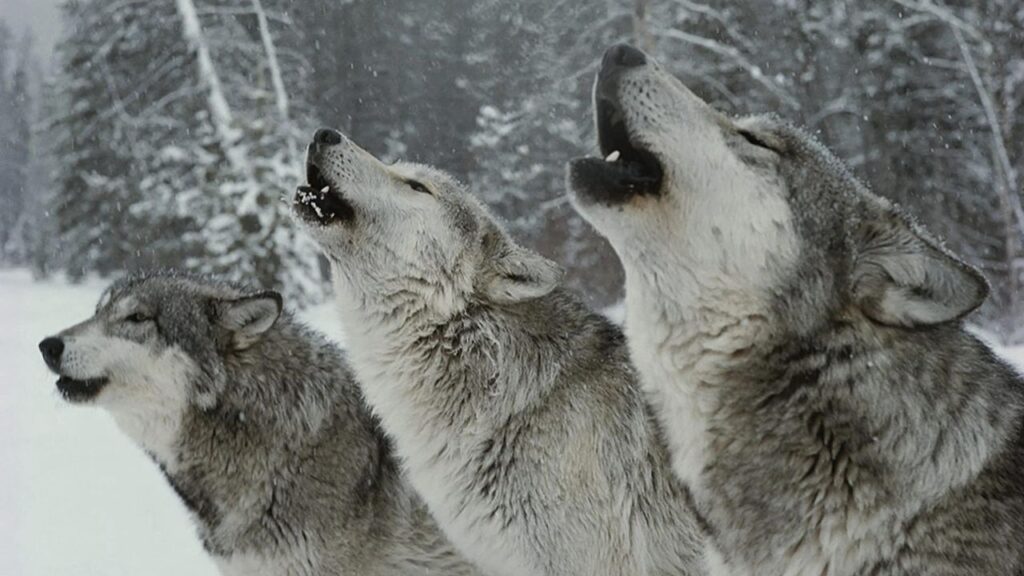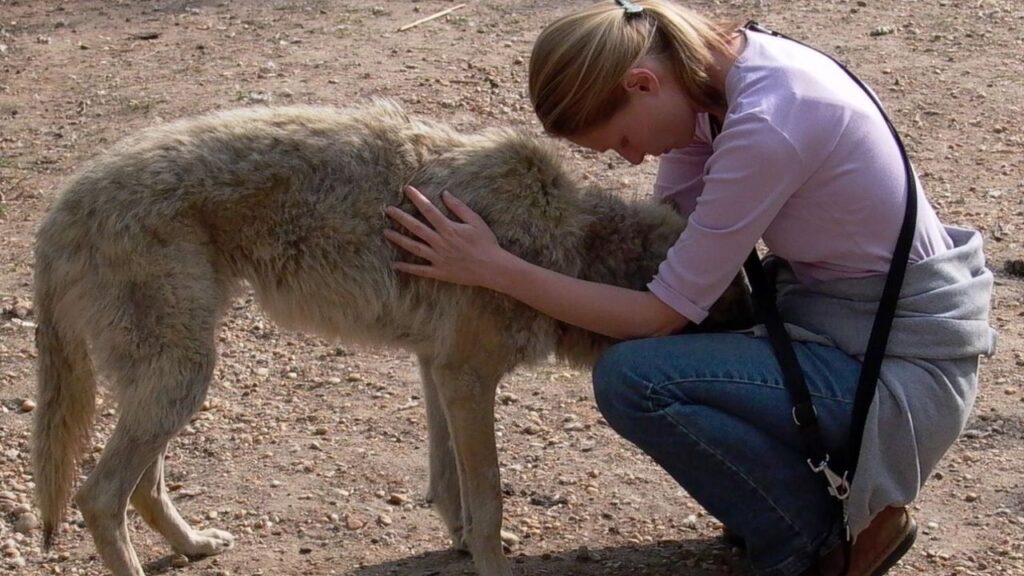Do Wolves Attack Humans? Wolves rarely attack humans, and when they do, it is often due to specific circumstances such as rabies or food conditioning.
The wolf, a creature often shrouded in mystery and fear, has been a subject of fascination and dread for centuries.
Stories of wolves attacking humans have permeated folklore, literature, and popular media, painting these animals as dangerous predators lurking in the shadows. But how much of this is rooted in reality?
In this comprehensive blog post, we will delve into the facts and myths surrounding wolf attacks on humans, exploring historical accounts, scientific studies, and modern-day data to provide a clear and nuanced understanding of this topic.
Contents
Who Are Wolves?
The Biology of Wolves
Wolves (Canis lupus) are large canids native to North America and Eurasia. They are social animals, living in packs that consist of a mated pair and their offspring.
Wolves are known for their complex social structures, sophisticated communication methods, and remarkable hunting skills.
They primarily hunt ungulates such as deer, elk, and moose, but their diet can also include smaller mammals, birds, and even fish.
Wolves are built for endurance. Their powerful legs and large paws enable them to travel long distances, sometimes covering 30 miles or more in a day.
Their keen senses of smell, hearing, and sight make them formidable hunters. The hierarchical structure within a wolf pack ensures efficient cooperation during hunts, with each member playing a specific role in the pursuit and capture of prey.
Wolves in Culture and History
Wolves have a long history of interaction with humans, often marked by fear and reverence.
In many cultures, wolves are seen as symbols of wilderness and freedom, but they are also frequently portrayed as villains in fairy tales and folklore.
This duality has contributed to the complex and often contradictory perceptions of wolves in human society.
In European folklore, wolves are often depicted as cunning and dangerous predators, as seen in stories like “Little Red Riding Hood” and “The Three Little Pigs.”
These narratives have helped cement the image of the wolf as a fearsome animal to be wary of. [Do Wolves Attack Humans?]
In contrast, many Native American cultures revere the wolf as a symbol of loyalty, strength, and family unity.
For example, the Pawnee tribe sees the wolf as a pathfinder, guiding hunters to their prey.

Do Wolves Attack Humans? The Data
Historical Accounts of Wolf Attacks
Historical records do contain accounts of wolf attacks on humans, particularly in Europe and Asia. These attacks were more common during periods when rabies was widespread among wolf populations.
For example, during the 18th and 19th centuries in France, there were numerous reports of rabid wolves attacking people, leading to widespread fear and efforts to exterminate wolf populations.
In medieval Europe, the fear of wolf attacks was exacerbated by frequent outbreaks of rabies. Rabid wolves, unlike their healthy counterparts, would lose their natural fear of humans and become highly aggressive.
This led to numerous attacks and a general perception of wolves as dangerous animals. Similar accounts can be found in Russia and other parts of Asia, where rabid wolves were responsible for many human fatalities.
Modern-Day Incidents
In contemporary times, wolf attacks on humans are exceedingly rare. [Do Wolves Attack Humans?]
A comprehensive study covering the period from 2002 to 2020 found only 26 fatal attacks worldwide, with most occurring in rural areas where wolves and humans live in close proximity.
In North America, there have been only two documented fatal wolf attacks in the last two decades, both involving unique circumstances that led to the attacks.
The majority of modern-day wolf attacks occur in regions where human encroachment on wolf habitats is significant.
For instance, in parts of rural India and Iran, wolf attacks are more common due to the overlap of human and wolf territories.
In these areas, wolves may come into conflict with humans over livestock or due to habitat destruction.
However, such incidents are still relatively rare when compared to attacks by other large carnivores.

Factors Contributing to Wolf Attacks
Rabies
Rabies is a significant factor in wolf attacks on humans. [Do Wolves Attack Humans?]
In the majority of historical cases, rabid wolves were responsible for aggressive behavior and attacks. Rabid wolves lose their natural fear of humans and can become extremely aggressive.
Fortunately, rabies control measures have significantly reduced the incidence of rabies in wolf populations, leading to fewer such attacks.
Rabies outbreaks among wolf populations have been largely controlled in many parts of the world through vaccination programs and the management of stray dog populations, which are a primary vector for the disease.
However, in regions where rabies is still prevalent, such as parts of Asia and Africa, the risk of rabid wolf attacks remains.
Human Behavior and Food Conditioning
Wolves generally avoid humans, but situations where wolves become habituated to humans or are attracted by food sources can lead to increased risks.
Improper disposal of food waste, intentional feeding of wolves, or presence of attractants like livestock carcasses can draw wolves closer to human settlements, potentially leading to conflict.
Food conditioning occurs when wolves associate humans with easy food sources. This can happen in areas where garbage is not properly secured or where people intentionally feed wolves.
Habituated wolves lose their natural wariness of humans, increasing the likelihood of encounters. In some cases, these wolves may become bold and approach human dwellings, posing a risk to pets and livestock.
Predatory and Defensive Attacks
While rare, predatory attacks do occur, usually involving wolves that are desperate for food or in poor health. [Do Wolves Attack Humans?]
Defensive attacks can happen when wolves feel threatened, particularly when they are protecting their young or territory.
These types of attacks are more common in areas where wolves are frequently disturbed by human activities, such as hunting or logging.
Predatory attacks are typically characterized by the wolf’s attempt to hunt humans as prey.
These incidents are extremely rare and often involve wolves that are in poor physical condition or have experienced a significant loss of natural prey.
Defensive attacks, on the other hand, occur when wolves perceive humans as a threat to their safety or that of their pack.
Such attacks are usually a last resort for wolves and can often be prevented through careful behavior by humans in wolf habitats.

Mitigating the Risk of Wolf Attacks
Wildlife Management Practices
Effective wildlife management practices play a crucial role in reducing the risk of wolf attacks on humans. These practices include:
- Fencing garbage dumps and landfills to prevent wolves from accessing food sources.
- Proper disposal of livestock carcasses.
- Public education campaigns to discourage feeding wolves and promote safe practices in wolf habitats.
Wildlife management agencies also monitor wolf populations and their interactions with humans.
In some cases, problem wolves that repeatedly come into conflict with humans may be relocated or, as a last resort, euthanized.
These measures help maintain a balance between wolf conservation and human safety.
Personal Safety Measures
For outdoor enthusiasts and those living in wolf territories, following safety guidelines can minimize the risk of encounters with wolves. These include:
- Keeping a safe distance from wolves and other wildlife.
- Hiking in groups and staying on established trails.
- Securing food and garbage to avoid attracting wolves.
- Using deterrents like bear spray if a wolf approaches.
In addition to these measures, it is important to be aware of wolf behavior and to avoid actions that could provoke an attack.
For example, approaching a wolf den or attempting to feed wolves can lead to aggressive behavior. Educating the public about these precautions is essential for reducing negative interactions with wolves.
See Also: Do Coyotes Attack Humans? Unseen Predators!
FAQs
Are Wolves Naturally Dangerous to Humans?
Wolves are generally not dangerous to humans. They have a natural fear of humans and prefer to avoid contact. Most wolf encounters in the wild are non-threatening and involve wolves observing humans from a distance before retreating.
What Should I Do If I Encounter a Wolf?
If you encounter a wolf, remain calm and do not run. Make yourself appear larger by raising your arms and make loud noises to deter the wolf. Slowly back away while maintaining eye contact. If the wolf continues to approach, use deterrents like bear spray.
Can Wolves Be Tamed or Domesticated?
Wolves are wild animals with complex social structures and behaviors that do not adapt well to domestication. While they share a common ancestry with domestic dogs, their instincts and needs are very different, making them unsuitable as pets.
How Common Are Wolf Attacks Compared to Other Animal Attacks?
Wolf attacks on humans are extremely rare compared to attacks by other animals such as bears, mountain lions, and even domestic dogs. In North America, you are more likely to be struck by lightning or attacked by a cow than by a wolf. This rarity is due to wolves’ natural fear of humans and their preference for wild prey.
Conclusion: Do Wolves Attack Humans?
The fear of wolf attacks on humans is largely unfounded in modern times. While historical accounts and rare incidents do exist, the risk of being attacked by a wolf is extremely low.
Wolves are an essential part of the ecosystem, playing a crucial role in maintaining the balance of their habitats.
By understanding their behavior and taking appropriate precautions, humans and wolves can coexist peacefully.
Wolves, like many large predators, have suffered from a long history of misunderstanding and fear. However, through education and effective management practices, we can foster a better relationship with these remarkable animals.
Recognizing the important role wolves play in the environment and respecting their space can lead to a harmonious coexistence where both humans and wolves thrive.

Hello, I am Rosa Ellis, a mother of two and a wildlife blogger. I grew up in New York City, but I love exploring forests. I’ve traveled to places like Yellowstone National Park and the Amazon Rainforest to see animals up close. I know a lot about animal behavior and which animals can be dangerous to humans. Thanks for visiting my blog!

